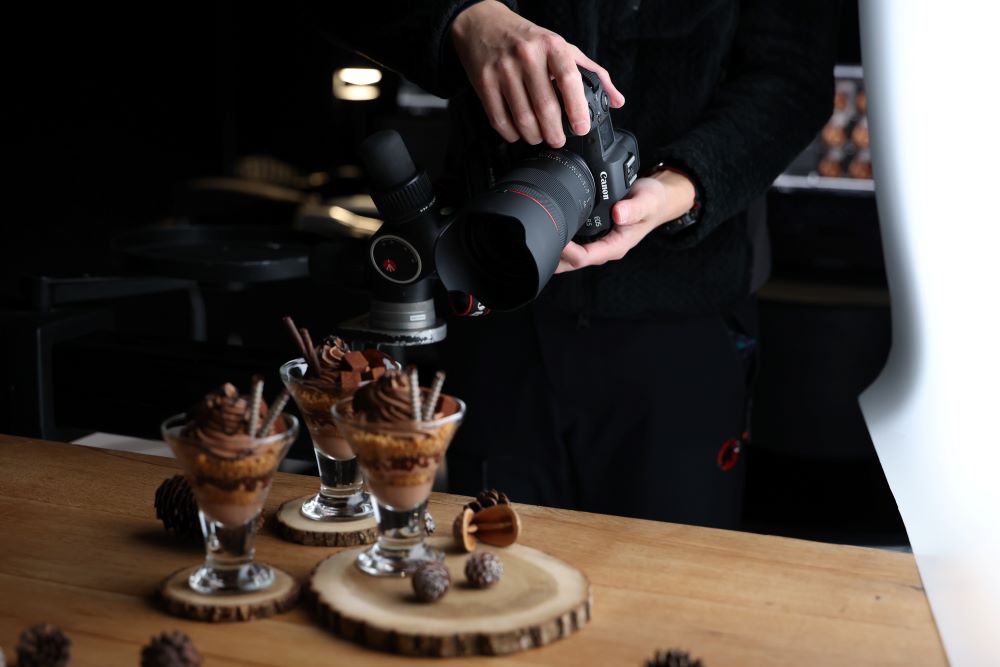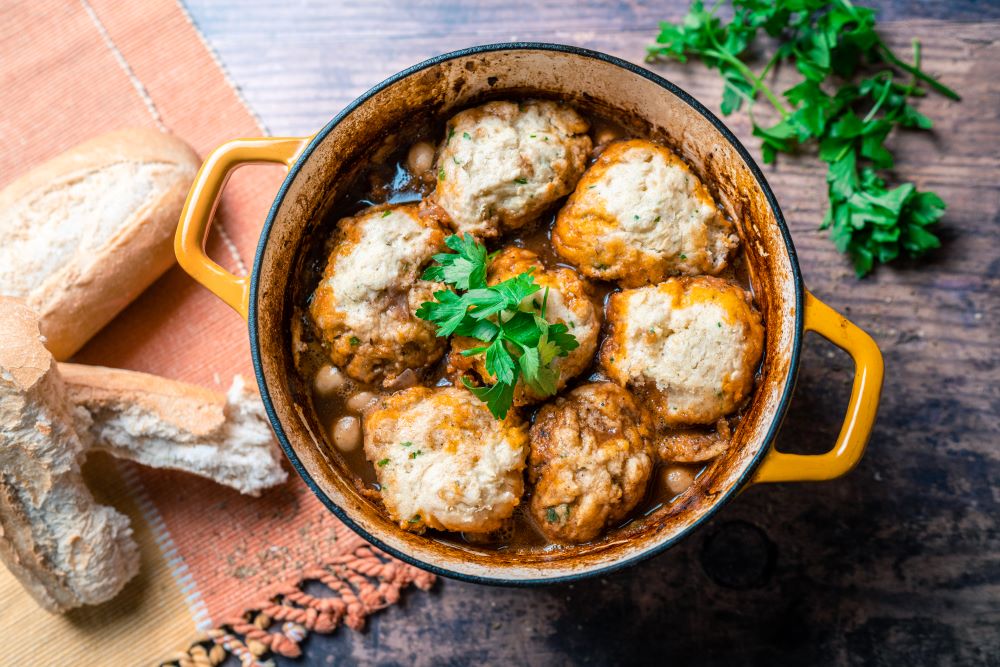- Call us: 01444 237070
- Contact Us
- Stores
- Sign In / Register
-
- Back
- Used Cameras
- Used Accessories
- Used Lenses
- Used Video
- Used Film Equipment
- Used Stock Alert
- Used Blank Test
- Sell or Part Exchange
- Used Clearance
- Recently Added Used Equipment
- Park Picks
- All Used Black Friday Deals
- Faulty
- Trade-In
- Blog
- New in
- Call us
- Contact us
- Stores
- Sign in
- Categories
- Tips & Inspiration
- Reviews
- News
- Events
- Features
- Buying Guides
- Competitions
Beginner’s Guide to Food Photography
For the photography enthusiasts amongst us, food photography can be a source of creative exploration regardless of weather, time or place. At first glance, it may not appear as involved as it truly is – it’s a genre that can teach you lots about all genres of photography, requiring a touch of artistry throughout.
Getting Started with Food Photography | Tutorial Tuesday Video
Gareth is going over everything you need to know to get started with food photography, from the equipment you'll need, to how to setup and style the food through to composition, angles and lighting.
Learning new genres of photography trains your photography brain, and opens your mind to new approaches. Taking professional food photos is a brilliant way to expand your arsenal of techniques, as opportunities to get started present themselves everywhere.
In this beginner’s guide to food photography, we’ll discuss the skills you’ll need to apply, the craft of setting up your scene, and the equipment you’ll need to make the most out of it. Read on to discover what makes this style of photography so engaging!
Food Photography Skills
As with all genres, food photography has its own unique set of techniques you need to apply to produce the best images. However, there’s also a remarkable amount of overlap – many of the skills required can be extrapolated from previous experience in genres like product or even portrait photography.
In the same vein, food photography ideas can also be applied across the board and can teach you new methods you wouldn’t have thought to use previously in genres both new and familiar. Below, we’ve listed some of our top food photography tips to help you get started:
- Use natural light: the ultimate way to give your food photography scenes a flattering look. Setting your scene close to a bright window is far more effective than harsh overhead lights. Lighting modifiers can be used to harness the power of natural light to your liking.
- Know your angles: always be aware of your angle's impact on the tone and feel of your photo. Are you taking bird's eye view, overhead shots? Are you shooting straight on, or perpendicular to the table to give a sense of depth? The best photographers know exactly where to shoot from to define the tone of their photo, which is essential for professional food photography.
- Use compositional techniques: with so much control over your setting, nailing your composition is crucial. Use ideas like leading lines, repeating patterns, the rule of odds and filling the frame to produce a shot that looks and feels considered. The composition also impacts feel – minimalism and negative space can create some truly unique photos.
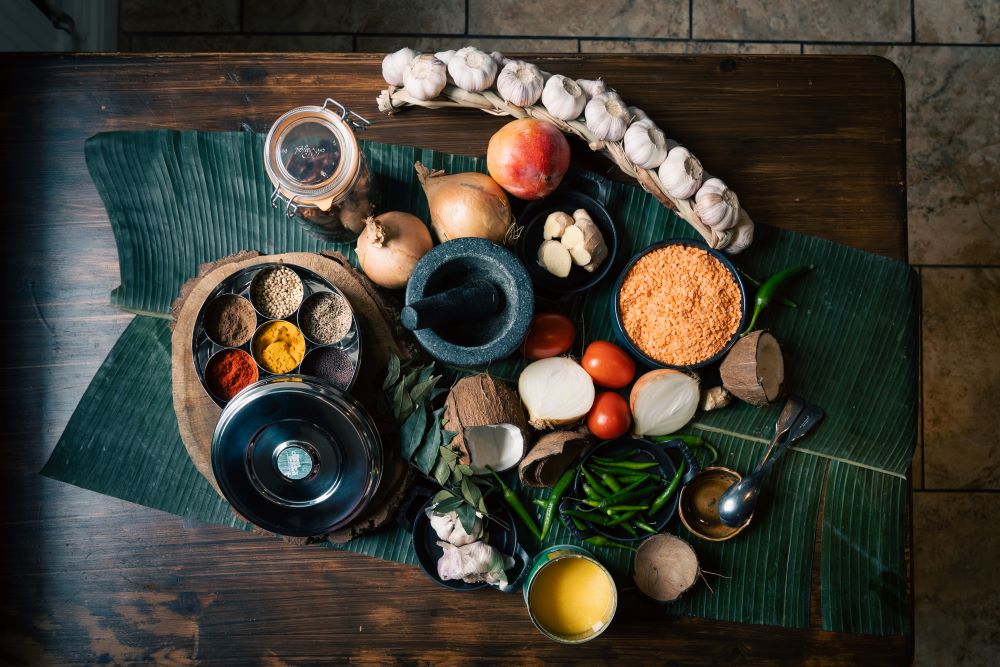
Sony A7 III | Sony FE 24-70mm f2.8 GM | 1/50 sec | f/5.6 | ISO 400
- Use props: it’s not all about the food! Forks, tea towels, tablecloths, empty plates and more can all give the impression of a natural mealtime scene. Combining this with artistic skill can make your photo captivating, appealing to the eye and full of emotion. Food photography backdrops can bring the whole thing together.
- Styling (and faking!): the most important thing to realise about food photography is that you are in control. If something in your scene isn’t perfect, sort it out. If you think it could be better, make it better with whatever’s available to make your food look as appetising as possible, even if you need to airbrush it a little.
- Know your camera: shooting manual and understanding every setting on your camera is vital to taking the photos you want to produce. Beyond your exposure settings, setting your focus perfectly and knowing your way around your camera’s scene modes will result in food photos that you’re proud of.
- Highlight the focus: perhaps the most crucial thing a good food photo does is draw your eye towards the main dish. This follows a combination of styling, preparation and the compositional rules discussed above – experiment to find the perfect way to emphasise your subject.
Creating a Food Photography Set
While it may not appear so at first glance, the food and its surroundings have to be meticulously prepared for food and drink photography. The whole idea behind taking food photos is to make your photos look perfect – this is done by exercising all of your control over your setting.
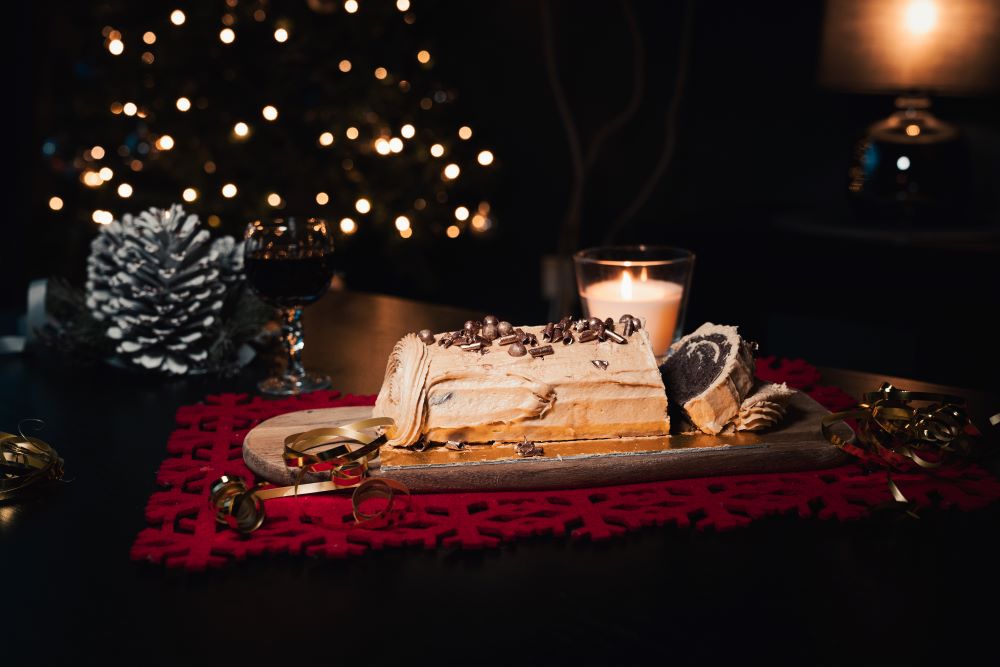
Sony A7 III | Sony FE 24-70mm f2.8 GM | 1/100 sec | f/4.5 | ISO 1250
Creating the environment around your food involves a knack for styling. One way to do this is to lean into the theme of your central dish – it’s essential to pair up your food with drinks and additional props that tie into the overall feel of your subject.
Focusing on a general theme is effective, but it doesn’t stop there. Using your intuition to perfectly balance colours, shadows and textures also leads to a creative food photography set. The latter can transform your photo into a sensory experience – keeping some crumbled-up food in the shot or leaving an empty plate can create a real tangible feel to your photo.
It may also be worth delving into some storytelling. One idea to follow is to progressively shoot the food as it’s being prepared or even eaten, inspiring a genuine atmosphere. This works for baked goods like cakes or bread, as the preparation process is engaging on its own, and capturing the food decreasing in size slice by slice can breathe life into your food photography.
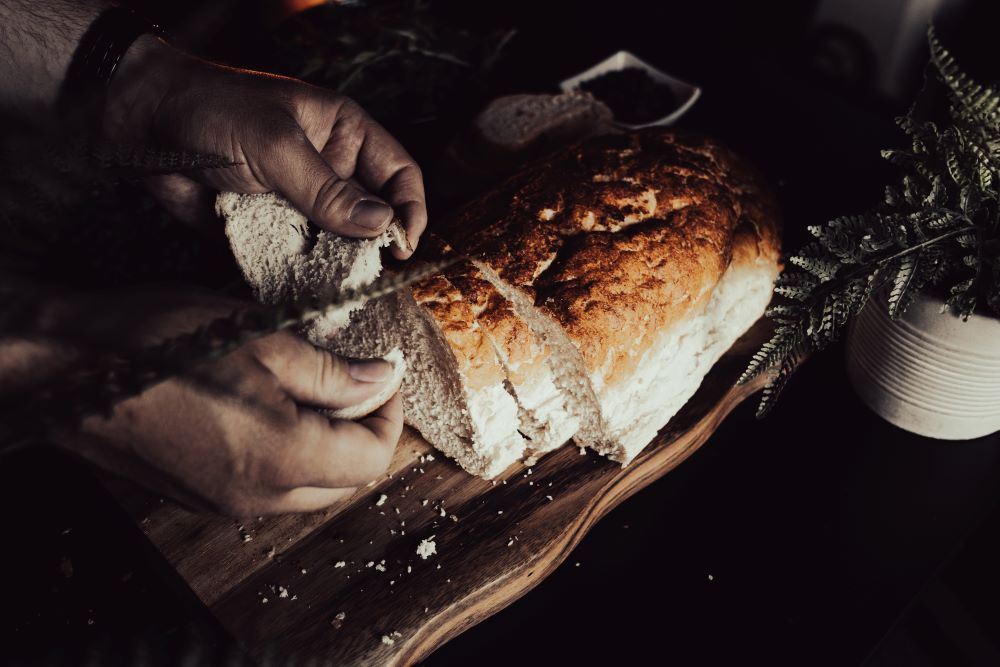
Sony A7 III | Sony FE 24-70mm f2.8 GM | 1/200 sec | f/4.0 | ISO 800
If it’s necessary, use any tools at your disposal to make your dishes look as mouth-watering as possible. Pros use a vast amount of equipment to do this – makeup sponges, cotton buds, spray bottles and tweezers are all popular improvised utensils to ensure everything is perfectly in place and looking inviting. Remember that you’re in control and you'll unlock new ways of embellishing your scenes.
Food Photography Lighting
Lighting dictates the feel of your image in all genres of photography – food is no exception. As you should understand by now, food photography enables a considered approach from start to finish, which you must extend to your lighting to take brilliant photos.
The best place to start with food photography lighting is to harness a natural light source. Almost every time, it will provide a flattering look that outdoes indoor artificial light. Setting up next to a window enables you to produce perfectly lit shots.
Occasionally, natural light is too bright and directional, creating unwanted shadows. This is where lighting accessories come in – diffusers, for instance, work wonders in softening the light for a more balanced look.
Sony A7R IV | Sony FE 35mm f1.4 ZA | 1/100 sec | f/4.0 | ISO 640
Many professional food photographers love using foam boards as makeshift light modifiers, as it’s an inexpensive hack that works wonders. For instance, white foam boards act like reflectors to counteract shadows, and black foam boards absorb it when higher contrast is ideal.
When natural light doesn’t cut it, flashes and continuous lighting setups are perfect when used carefully. Tools like softboxes and reflectors can replicate that diffused look. For maximum control over your scene, continuous lighting is ideal to take the guesswork out of your lighting. Rotolight, for instance, is an excellent manufacturer of versatile lights, providing flexibility to all kinds of photographers.
Best camera for food photography
A lot of those looking to get started with food photography aren’t necessarily looking for the cutting-edge when it comes to their camera. Most simply want something ergonomic and simple to use, but also want the power and control required to take perfect photos.
Most mirrorless cameras today are perfect for a variety of photography styles, including food photography. For resolution, full-frame mirrorless cameras are the ultimate choice, with the option of medium-format cameras like the Fujifilm GFX 100S II for those who want an even higher megapixel count.
However, smaller sensor sizes like Micro Four-Thirds and APS-C cameras may also be preferable as the reduced form factor gives just a little more flexibility with how the camera is used. Cameras like the Canon EOS R50 are perfect for those who want to capture beautiful high quality stills without cashing out on bulkier gear.
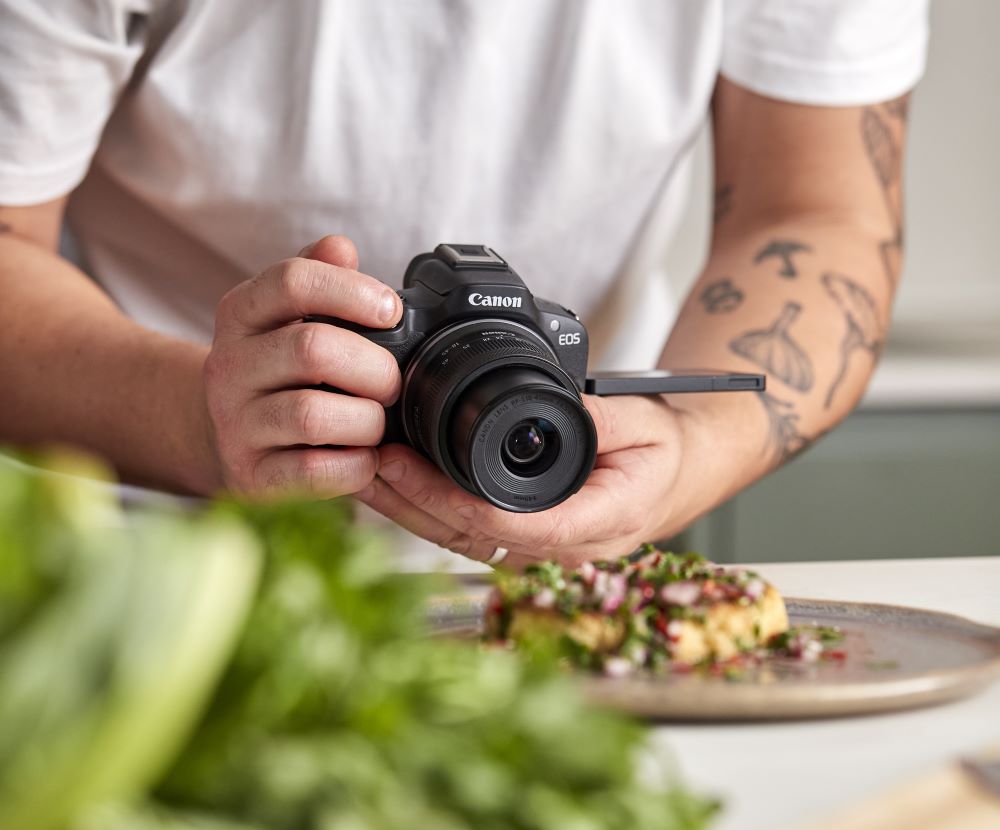
Canon EOS R50 + Canon RF 18-45mm f4.5-5.6 IS STM
Even compact cameras like the Sony RX100 VII and the Ricoh GR IIIx can be incredibly useful in the hands of a skilled food photographer. Their size means there’s virtually no limit on the angle you shoot from, making your experience much more versatile.
With the general trend moving towards more versatility from digital cameras, Wi-Fi connectivity and easy-to-use shooting modes enable content creators to seamlessly integrate their social media goals into their photography. These can be found in many recent mirrorless cameras, which is important to look for if you want to share your culinary photography with friends, family and more.
Lens choices
Perhaps more important than the camera you’re using, the lens you choose will have an undeniable impact on your food photos. It’s crucial to know what you need out of the best lens for food photography.
The first consideration to make is regarding focal length. Prime lenses are a favourite among food photographers, as their unmatched sharpness combined with wide maximum apertures produce crisp images with gorgeously shallow depth of field.
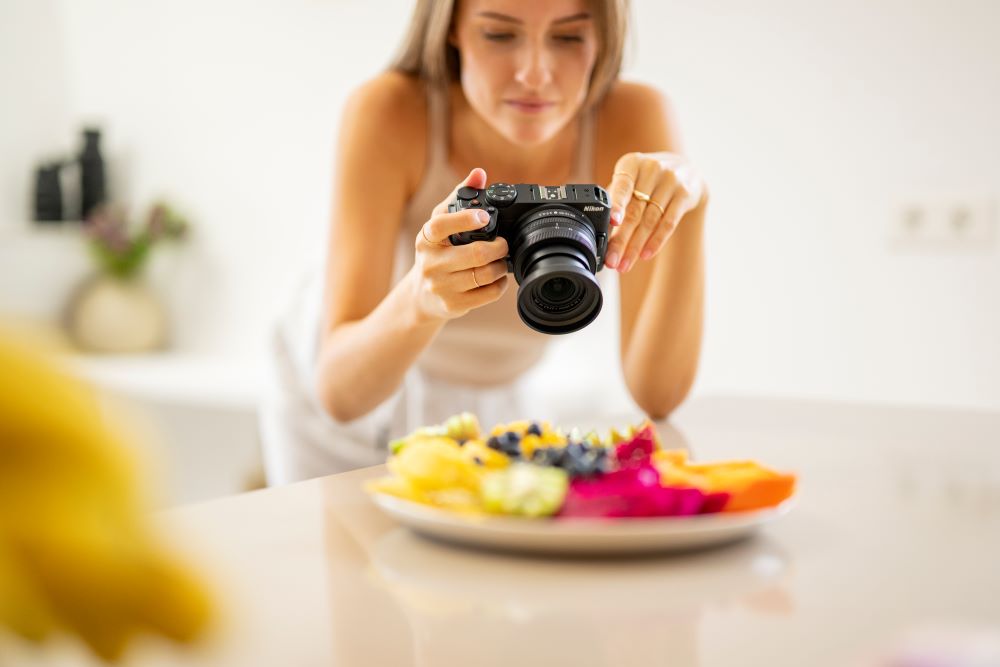
Nikon Z30 with Z DX 16-50mm f3.5-5.6 VR
35mm and 50mm are the two focal lengths most commonly used by food photographers. They’re very natural in terms of distortion and lens compression and avoid going too wide (as to distort the image) or too close to the subject, which is only essential in macro food photography with tailored lenses. Sigma’s Art lenses are a brilliant choice, with the 35mm f/1.4 DG DN Art and the 50mm f/1.2 DG DN Art lenses for the Sony E-Mount and the L-Mount outperforming the competition.
While primes are popular, zoom lenses are used just as much by food photographers. The added versatility of changing focal length makes the process a lot simpler, allowing you to land on the perfect composition much faster.
The classic 24-70mm f/2.8 lens is almost certainly the best zoom lens for food photography, with options from Sony, Nikon, Canon and more being perfect for your system of choice. They combine almost all focal lengths you’d want for food photography with a wide max aperture for those blurred backgrounds. From Sigma, the 28-45mm f/1.8 DG DN Art lens has the widest aperture of any full-frame mirrorless lens, blurring the line between zoom and prime lenses.
Choosing a Tripod for Food Photography
A tripod is arguably the best starting point in a food photography setup – while shooting handheld gives you some extra versatility, using a camera and tripod combo allows you to fine-tune and perfect your composition, and not worry about camera shake, allowing you to increase shutter speed and lower ISO.
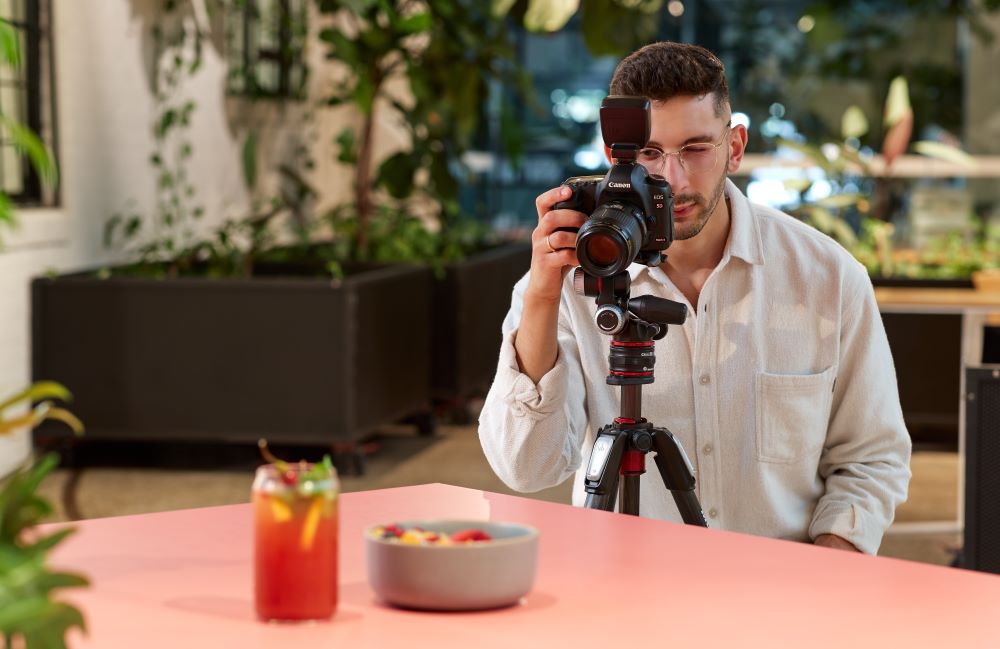
Depending on your studio (or your kitchen!), you’ll need to choose the perfect tripod for you. A larger premium tripod from the likes of Manfrotto, Benro, Gitzo and 3 Legged Thing is brilliant if you’ve got a little more space and budget, with great options across the board. Food photographers should be looking for adjustability more than anything – the Manfrotto MT055XPRO3 Aluminium tripod is a perfect trade-off between portability, flexibility and ruggedness.
If your shoots require less of a heavy-duty tripod, the Benro Slim TSL08 Carbon Fibre Tripod weighs barely a kilogram and has a slim profile, meaning it can be deployed almost everywhere. As a tripod for food photography isn’t as demanding in terms of robustness, this choice could be your perfect companion.
Conclusion
We hope this tutorial has given you the perfect introduction to the brilliant genre of food photography, and equipped you with the tools to get started today.
In August 2024 we teamed up with the Kent Cookery School and Sony UK to host a full-day food photography course / workshop, where participants captured a range of cuisines in dozens of different settings. This provided the opportunity to work with a chef as well as engage with a Sony technical expert in order to ask questions about the Sony Alpha ecosystem.
This food photography course has now ended, but more dates will be available soon. Visit our events page to see what's coming up and sign up below to receive notifications about future events.
Explore our vast range of digital cameras, lenses and more from all your favourite brands to build the perfect food photography setup today.
Share this post:
By Thom Pyle on 22/06/2024

Trade in your old equipment
Fast and easy trade in service ensures your old gear is collected efficiently and you are paid quickly! It's very simple to trade in your unwanted photography gear. Just head over to our dedicated Sell or Part Exchange page, fill out the details, and we'll get back to you with an offer for your old gear. Take the cash, or put it towards the cost of your new gear. It's up to you! Find out more
sign up to the newsletter
Keep up to date on the latest photography news, events and offers. Sign up now
